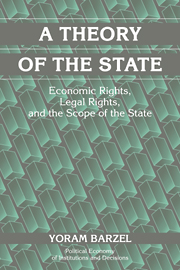Book contents
- Frontmatter
- Contents
- Preface
- 1 Introduction
- I The Emergence of Protection and Third-Party Enforcement
- II The Emergence of Legal Institutions
- III The Character of the State
- 12 Merger and Local Autonomy
- 13 The Distinction between “Legitimate” and “Criminal” States
- 14 Power, Violent Conflict, and Political Evolution
- 15 The Time Path of Change under Dictatorships and under Rule-of-Law Regimes
- 16 Recapitulation and an Epilogue
- References
- Index
- Other Books in the Series
15 - The Time Path of Change under Dictatorships and under Rule-of-Law Regimes
Published online by Cambridge University Press: 04 December 2009
- Frontmatter
- Contents
- Preface
- 1 Introduction
- I The Emergence of Protection and Third-Party Enforcement
- II The Emergence of Legal Institutions
- III The Character of the State
- 12 Merger and Local Autonomy
- 13 The Distinction between “Legitimate” and “Criminal” States
- 14 Power, Violent Conflict, and Political Evolution
- 15 The Time Path of Change under Dictatorships and under Rule-of-Law Regimes
- 16 Recapitulation and an Epilogue
- References
- Index
- Other Books in the Series
Summary
I have argued (Barzel, 2000a) that people create institutions in order to prevent confiscation and use “checks and balances” to enhance the viability of those institutions. Severe shocks tend to upset the checks and balances and increase the probability that one individual or another will be able to usurp power and become a dictator. In that paper I also described some of the features of dictatorships and the conditions under which those regimes can evolve into rule-of-law states.
In this chapter, I first explore the notion of shock and the paths its effects can take, followed by an inquiry into the distinction between mild and severe shocks. I then compare, along two main dimensions, dictatorial regimes and regimes governed by rule of law. First, I ask how an outside threat will affect each of the regimes. Second, I examine how the two regimes differ in terms of (1) the rights held by the head of state, (2) the state's participation in enterprises, (3) the extent to which legal rights are developed in the state, and (4) the distinction the states make between legal rights and economic rights.
THE EFFECTS OF SHOCKS
At any point in time there is a balance of power between protector and clients. Each particular balance will determine what actions the protector can take, as well as the size of his reward. A shock upsets such a balance and, more importantly, increases the level of uncertainty in the assessment of power. As a rule, the damage caused by a shock is not evenly distributed across states, nor is it within a state.
- Type
- Chapter
- Information
- A Theory of the StateEconomic Rights, Legal Rights, and the Scope of the State, pp. 250 - 266Publisher: Cambridge University PressPrint publication year: 2001

